

Today’s Eye Opener 1 minute
Which of the following apply to you:
*Note: This is not an exhaustive list of characteristics
Ethnically diverse
Not male
Person with disability
Educated beyond secondary school
Religious
Strong acccent
An unpaid carer
Over 50
What if you were told to select just one of the previous characteristics to describe you? How easy would that be?
Very easy
Easy
Neutral
Difficult
Very difficult
We often focus on just one issue, like “race” or “gender,” when talking about diversity at work. But as this activity showed, everyone has many identities that make them who they are, hence we don't fit into just one box.
Video – 2.5 minutes
Watch this video to find out exactly what intersectionality is https://www.youtube.com/watch?v=gN2ecPsg4xo
What is intersectionality?
Intersectionality means understanding that everyone has many different parts to their identity, like race, gender, sexuality, and class. These parts combine to make each person unique. For example, both a "White heterosexual male" and a "Black lesbian woman" have identities made up of these different parts.
Think of intersectionality like a Venn Diagram. Each circle stands for a different part of your identity. The areas where the circles overlap show how these parts come together and affect your experiences. At the centre is you, shaped by this unique mix of identities. This helps to highlight how different we all are.
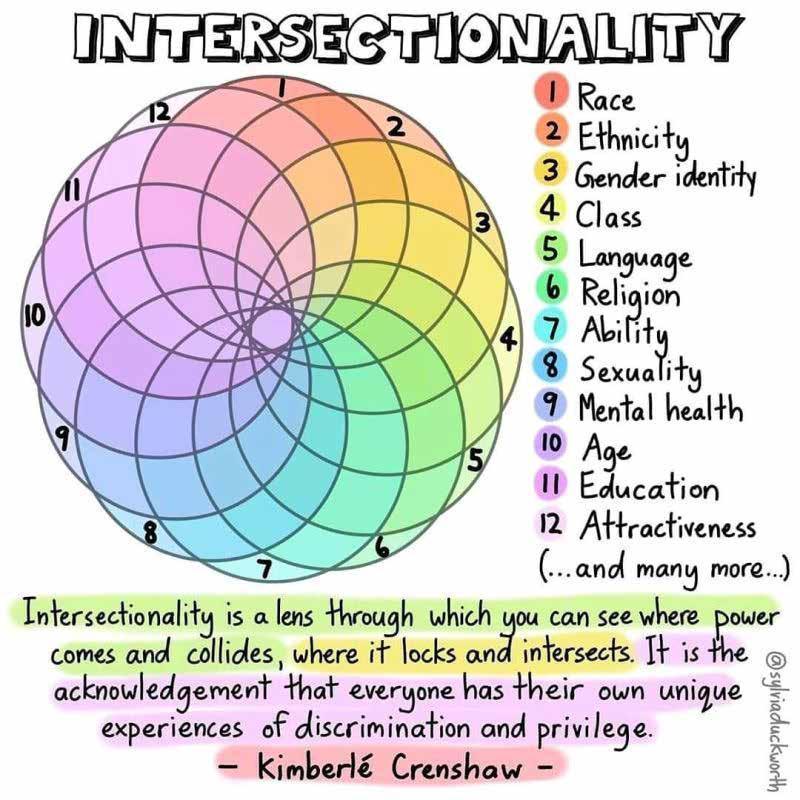
However, some people face more challenges because they belong to multiple marginalised groups.
Intersectional disadvantage
Looking at the statistics, ethnically diverse employees face disadvantages due to their additional characteristics.
For example,
g a Black woman faces sexism because she is a woman and racism because she is Black. This has real impact on her opportunities and career progression.
g Black and South Asian women face longer delays in securing their first jobs compared to their white counterparts, despite being equally or more qualified according to Total Jobs and Diversity Trust research.
g Black disabled women and girls are often denied equal access to training and education resources.
g Asian women are seven times more likely to be mistaken for someone of the same ethnicity. McKinsley&Co 2023.
Data gathered by The Collaboratory and Race Equality Matters revealed that:
44% 13%
of respondents say their company’s hiring practices do not reflect an understanding of intersectionality.
Despite intersectionality being present throughout our organisations only
said their workplace created a sense of community for people with intersectional identities.
This shows how important it is for workplaces to understand the effects of intersectionality and to work on reducing its disadvantages.

Action: 1 minute
How can you support colleagues with multiple marginalised identities and promote an inclusive workplace culture?
g If you’re comfortable, share your own intersectionality with others to promote intersectional thinking.
g Attend a ‘Race And’ event hosted by Race Equality Matters.
g Support the creation of safe spaces (e.g Tea Break) for people to share experiences, thoughts and feelings of their intersectionality.
g Strike up a conversation with someone with a different background to you and see what you can learn from each other.
g Encourage inclusive language and practices in meetings, ensuring that everyone’s perspectives — especially those from underrepresented ethnic groups — are heard.
g When you are talking to a person always remember that they are multidimensional, not one-dimensional.
Here is one action you can take as a senior Leader
Support the mental well-being of employees with intersectional identities by reviewing and enhancing policies and benefits to ensure they are inclusive, practical, and responsive to diverse needs.
Action/s I will take:
Action/s I will take: To be achieved by
If you are interested and would like to find out more.
Please see our additional resources:
Watch this video to find out really simply intersectionality is and how it impacts people
What is Intersectionality
Intersectionality 101: Definition, Facts and Examples
Intersectionality Matters! A podcast with Kimberlé Crenshaw- the founder of the term intersectionality:
If you found today's challenge helpful you can support us to create more solutions
Race Equality Matters provide many solutions resources and events for free, so:
1. Everyone can access them, regardless of budget.
2. The real barriers to race equality in the workplace are addressed.
3. The change we all want to see and feel, is accelerated.
91% say what we are doing will make an impact.
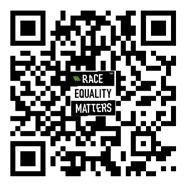
If you or your organisation can help, your donation will mean the world and help end racial inequality. Thank you (Donate via this QR Code)












Today’s eye opener 30 seconds
g Do you feel safe sharing your thoughts in meetings without fear of negative consequences?
g Have you ever been able to take time off for personal or family needs without feeling guilty or fearing it would negatively impact your career?
g Have you ever received mentorship or guidance from someone in a senior position?
g Have you ever been offered opportunities for career advancement or special projects without having to ask for them?
Some people are able to tick most of these boxes, but others cannot tick any.
Thinking about these questions can help you understand how privilege affects the workplace.
Privilege isn’t something we can control, but we can choose how we use it.
Recognising our own privilege — whether it’s based on race, socioeconomic status, or other factors helps us understand how we can support others, especially those from marginalised racial or ethnic groups.
Video – 4 minutes
Watch this video which shows how privilege is often unearned, through a visual exercise https://www.youtube.com/watch?v=hD5f8GuNuGQ

Could you be privileged without even knowing it?
Some people have certain opportunities or things they don’t have to worry about such as:
1. Having your voice heard and your opinion taken on board
2. Being comfortable to say no
3. People pronouncing your name correctly
4. Not having an accent.
Some people don't have any of these privileges. Reflecting on this helps us recognise our own advantages.

Privilege is Relative
The concept of "privilege" can stir debate, yet it's crucial to acknowledge your own advantages to effectively support others. Privilege and power are always relative; we are always more privileged than someone and less privileged than someone else. Look at the following “Wheel of Privilege”:
Wheel of Privilege

The further you are from the centre (“power”), the more you may have been discriminated, marginalised or deprived of equal opportunities. However, as you consider different categories, notice how your level of power changes.
You might catch yourself thinking, "I’ve had it tough, too" or "I have worked hard to get where I am." Having privilege does not negate your hard work or personal challenges.
We all have existing forms of privilege. Allyship involves using your privileges to support those who have less, and recognising that some individuals have more advantages than others.
Adapted from ccrweb.ca image by @sylviaduckworth
Equality vs Equity
Look at the following image:

Reality highlights how privilege advantages some more than others.
Equality assumes everyone’s needs and circumstances are broadly the same, giving everyone the same opportunities to watch the baseball game.
But Equity understands that people have different circumstances and needs. By providing different types of support, we can level the playing field, ensuring everyone can watch the game.
By using fair practices, organisations can build a workplace where everyone feels included and supported, regardless of their starting point.
Action – 45 seconds
How can you become an active ally and use your privilege to remove barriers and obstacles for others? Ideas to consider:
g Amplify voices and actively listen - to people from diverse backgrounds, for example if a colleague from an ethnically diverse background is spoken over in a meeting, respectfully intervene. For example, "Sorry, can we go back to what Muhammad was saying? I’d like to hear more about that."
g Respectfully challenge harmful behavior - both in person and online for example, If you hear someone make a racially insensitive comment, address it. For example, "I don’t think that’s appropriate, and here’s why..."
g Actively listen to people from diverse backgrounds.
g Visit #ItsNotMicro to learn how to confidently challenge microaggressions in a non-confrontational, respectful way.
g Always be inclusive for example when planning projects and social events so that everyone has an opportunity to be involved.
Here is one action you can make as a senior leader
Consider reverse mentoring. This is where a colleagues is mentored by someone from a different background. You both can grow and share knowledge with each other.
To find out more about membership click here: raceequalitymatters.com/become-a-member/
Action/s
I will take:
Action/s I will take: To be achieved by
If you are interested and would like to find out more.
Additional Resources:
What is privilege?
Famous “school race” video on privilege:
White privilege: What is it and how can it be used to help others?
10 Ways to Be a Better Ally and Use Your Privilege for Power
How to use your privilege to even the playing field
How to check your privilege- A podcast by Myisha T Hill
You can help us
If you found today's challenge helpful you can support us to create more solutions
Race Equality Matters provide many solutions resources and events for free, so:
1. Everyone can access them, regardless of budget.
2. The real barriers to race equality in the workplace are addressed.
3. The change we all want to see and feel, is accelerated.
91% say what we are doing will make an impact.

(Donate via this QR Code)
If you or your organisation can help, your donation will mean the world and help end racial inequality. Thank you
our key partners and collaborators












Today's Eye Opener
15 seconds
How often do you describe someone by their race or ethnicity by saying “The Black guy”, or “the Asian woman”?
Never Rarely
Occasionally Often Always
Words are extremely powerful they can bring joy but also bring pain
Video – 1 minute
Here is an overview of reasons why inclusive language is important
Watch this video: https://www.youtube.com/watch?v=5MQSFp_q-sc&t=1s
Why Inclusive Language Matters
• Language shapes how people are seen and treated
• Non-inclusive language can offend, upset or make people feel that they don’t belong
• Inclusive language ensures everyone feels valued and heard
• It creates a respectful and welcoming environment. By recognising and respecting individual identities and experiences, inclusive language helps create a culture where everyone can thrive and belong.

Inclusive language isn’t just about choosing different words. It’s a meaningful way to bring people together, helping us all to understand and respect each other’s unique lives and experiences. For the person hearing it, it can be a profound affirmation that they belong, are seen, and are valued.
Rachael Evans, Co-Founder of NewEdj LLC, Strategist and Lecturer
Language Do’s and Don'ts
Do use inclusive greetings.
'Ladies and gentlemen' 'Hi guys'
Don’t use racial identifiers unnecessarily
Refer to the person by their role or name or what they are wearing. 'the Black employee'
'Hi everyone' 'chairman'
'Hello all'
Do use gender neutral terms
'chair'
Avoid assumptions based on appearance
'Where are you really from?'
Can you tell me more about your background?"
(If relevant to the conversation.)
Don’t use stereotypes
You are intimidating / aggressive
Don’t make jokes at the expense of any group
you don't look autistic that’s a bit gay
Avoid language that derives from negative stereotypes about any group
Don’t use outdated terms
Mixed Heritage multiracial

What if I get it wrong?
It's okay to learn and grow with inclusive language. We are all human, and mistakes will happen. Language is constantly changing and evolving. Most people appreciate discussing issues and are willing to understand and forgive slip-ups rather than avoiding or ignoring important matters. What matters most is how you handle those learning moments. These conversations will help to create an inclusive environment.
• Be open to feedback
• Acknowledge and apologise - don’t be defensive
• Learn to get it right for next time
• Move forward - don’t dwell on it
Going through this process shows that you are open to inclusion and respect, and the thoughts and feelings of others.
Action – 1 minute
What steps can you take to ensure your language is more inclusive in both written and verbal communication? Ideas to consider:
g When discussing someone’s background, ask open-ended questions. For example, what traditions do you celebrate?
g If you come across a name you are unfamiliar with, then you could say: “I know how important names are, can you tell me now to correctly pronounce your name?”
g Use people’s preferred terms - This approach centers on the people and not on their characteristics, e.g., “people with disabilities”, “person with autism”, “person with diabetes”, etc. This humanises the individual and removes labels such as “disabled”, “autistic”, it puts people first.
g Use inclusive greetings like "Hi everyone" or "Good morning team" instead of "Hi guys."
g Use gender-neutral language in emails. For example, "Dear Team" instead of "Dear Gentlemen."
g When discussing someone's personal life, use neutral terms. For example, if appropriate, ask "Do you have a partner?" instead of "Do you have a husband/wife?"
g When acknowledging contributions, use neutral terms. For example, "Great job everyone," instead of "Great job, guys."
Here is one action you can make as a senior leader
People may have their own preferences when it comes to how they want to be addressed. This means that leaders need to remain open, curious, and willing to seek different perspectives. Rather than shutting down a conversation because you are afraid of saying the wrong thing
Action/s I will take: To be achieved by Action/s I will take:
Interested and would like to find out more?
Please see our additional resources:
The following resources include up to date, detailed information about inclusive language and terminology:
Inclusive language: How to use and promote it in your organisation:
Why inclusive lanaguage is important in the workplace
Writing clear, inclusively and compassionately
A guide to accessible communication
A glossary of LGBTQ+ terms
What is inclusive lanaguge and how to get ahead
You can help us
If you found today's challenge helpful you can support us to create more solutions
Race Equality Matters provide many solutions resources and events for free, so:
1. Everyone can access them, regardless of budget.
2. The real barriers to race equality in the workplace are addressed.
3. The change we all want to see and feel, is accelerated.
91% say what we are doing will make an impact.

(Donate via this QR Code)
If you or your organisation can help, your donation will mean the world and help end racial inequality. Thank you












Today’s Eye Opener 15 seconds
How often do you find yourself changing the way you act and speak in the workplace to fit in
Never Rarely Occasionally Frequently Always
What is code-switching?
Code-switching (also known as Masking and not being able to be your authentic self) is when people change how they speak, behave, or present themselve based on their social surroundings or audience. The aim is to fit in and not be seen as an outsider or someone who doesn’t belong.
We all naturally adapt to different situations.
However, for many people, the need to change who they are can be significant, for some more than others. As a result, code-switching can have a profound impact on their interactions and identity, shaping them in meaningful ways.
People code-switch to fit in, avoid exclusion, and in some cases, to simply to survive.
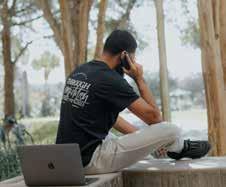
75% of ethnically diverse women have changed their demeanour to appear more ‘approachable and friendly’ during a job interview, in an attempt to counteract negative stereotypes.
Video: 2.5 minutes
To code-switch or not to code-switch
Lucrece Grehoua explores why code-switching is used as a mechanism for many people of colour https://youtu.be/jYvmNHfqiKI?si=bHDHSQ-YWf3rFumL
Why do ethnically diverse individuals code-switch more, and how does this impact wellbeing?
People who are part of marginalised groups often encounter stereotypes that portray them negatively (e.g. a Black man may be stereotyped as dangerous).
These stereotypes lead to discrimination and create challenging environments where individuals feel the need to adapt their behaviour to fit in and succeed (e.g. a Black man might code-switch to a less assertive tone or a certain dressing style in certain environments to avoid the stereotype).

According to the Harvard Business Review, these are the three main reasons ethnically diverse colleagues code-switch in the work place:
1
2
3
To increase their chances of being hired by downplaying their association with groups that face discrimination so they appear more “professional”.
To avoid negative stereotypes: Black men, for instance, are often stereotyped as "aggressive" or "intimidating." This leads many to adopt softer tones or overly polite behaviour to counteract these perceptions.
To connect with those with powerful and influence by expressing shared interests, which improves their chances of promotion since people tend to favour those they see as similar.
Pooja Kothari,
the founder of Boundless Awareness, says that code-switching at work can impact employees’ mental health. However, those who don’t need to code-switch feel more comfortable as they can be themselves without the extra mental effort to fit in.

Action: 1 minute
It is important that we feel as though we can bring our authentic selves into work. How can you contribute to reducing the necessity for ethnically diverse colleagues to code-switch in the workplace? Ideas you could consider:
Listen actively to colleagues from different backgrounds without interrupting or assuming stereotypes.
Make sure everyone has a chance to participate in meetings, discussions, and social activities, no matter their cultural background.
Share your stories about your culture in a safe space to build trust and authenticity, making it easier for people to learn and do the same.
Respect and acknowledge cultural practices, holidays, and traditions.
Be open to the idea of changing the way your team works to accept a different method or cultural norm.
Challenge assumptions, stereotypes and biases to make sure everyone feels valued.
Visit #ItNotMicro to learn more about microaggressions and how you can address them confidently and in a non-confrontational way.
Model inclusive behaviours in your daily interactions:
Here is one action you can take as a senior leader:
Lead by example. Sign your organisation up to try one of Race Equality Matters’ solutions as a way to create an inclusive environment, such as #MyNameIs. Lead by example, check how to pronounce a name you’re not familiar with, create a safe space for colleagues to share the meaning and heritage behind their names and ensure colleagues are called the name that they want to be called, (not an anglicised or shortened version).
To find out more about membership click here: raceequalitymatters.com/become-a-member/
The Cost of Code Switching Understanding code-switching: How does code switching impact teams? The Mental Health Costs of Code-switching:
You can help us
If you found today's challenge helpful you can support us to create more solutions
Race Equality Matters provide many solutions resources and events for free, so:
1. Everyone can access them, regardless of budget.
2. The real barriers to race equality in the workplace are addressed.
3. The change we all want to see and feel, is accelerated.
91% say what we are doing will make an impact.

(Donate via this QR Code)
If you or your organisation can help, your donation will mean the world and help end racial inequality. Thank you
our key partners and collaborators











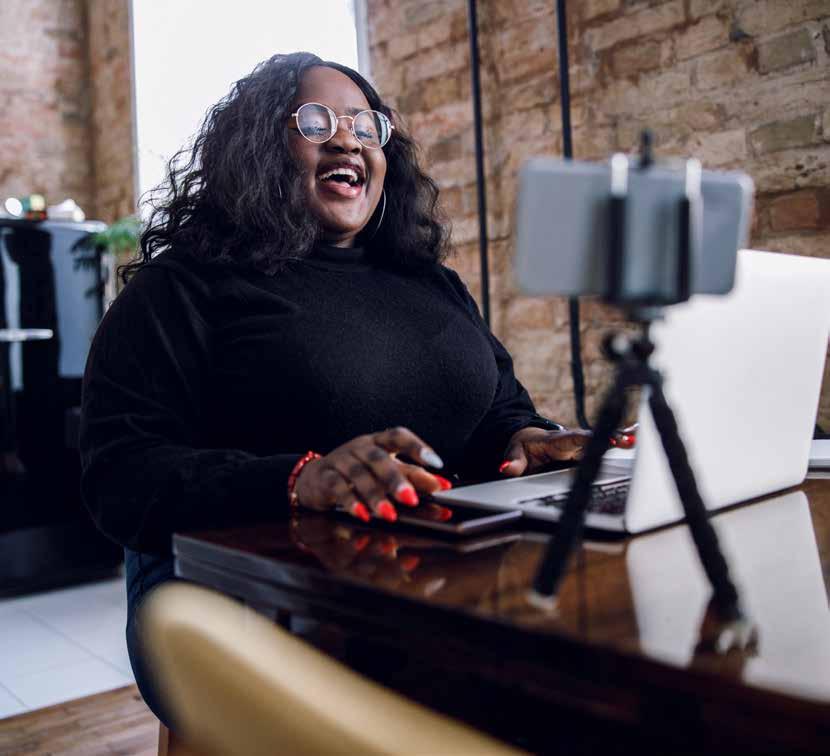
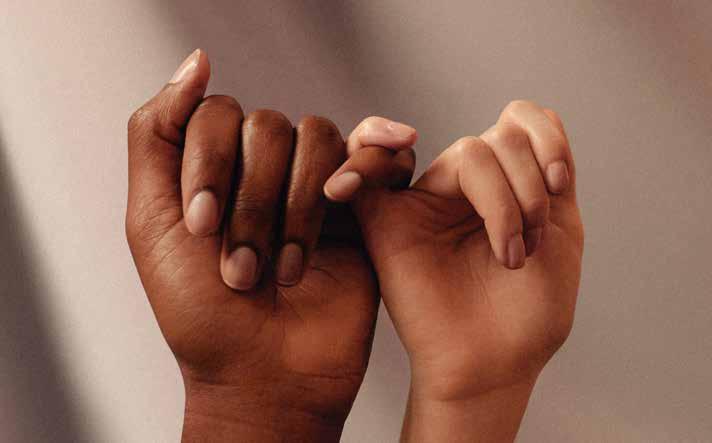
The Big Promise Day
In the 5-Day Challenge we have explored just some of the key and daily issues that are so hurtful, damaging, and excluding to your ethnically diverse colleagues, community friends and families (we appreciate many of you may have experienced issues directly yourselves).
Do we step back, walk away, ignore, or take action?
The only way to achieve equity and equality is for each and every one of us to take action.
The theme for Race Equality Week 2025 is #EveryActionCounts urging us all to grow personally and as a community. Over the last four days, we've discussed how crucial it is to recognise and confront our own behaviours and biases that uphold inequality.
Now, it’s time to:
Take action by reflecting on your own ssumptions. Growth starts from within.
Take action by challenge the systems, behaviours, and structures around you that uphold inequality.
Take Action by engage with your community, workplace, and society to foster race equality.
By embracing #EveryActionCounts we move beyond passive awareness to active transformation.
It’s time to make your Big Promise—challenge what’s wrong and be part of the change you want to see!
You can start to change the world today by making your Big Promise now: go to the Big Promise tool
Why The Big Promise?
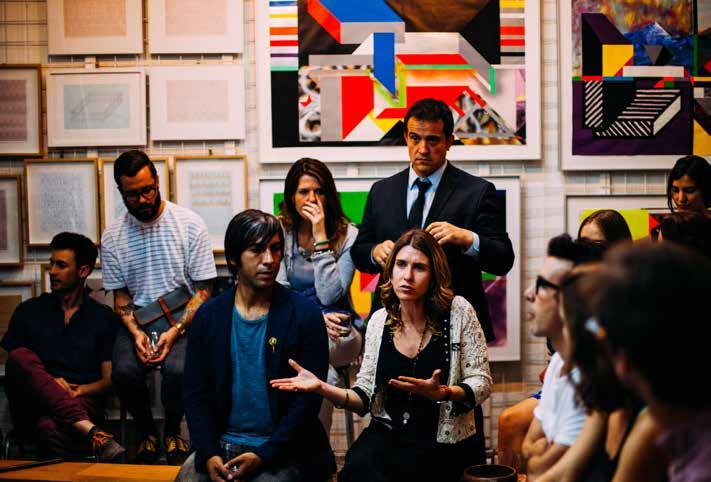
Race Equality Matters carried out in-depth interviews and research, which evidenced that the majority of ethnically diverse employees feel that there has been very little visible action to move towards the deeper and more meaningful change required to drive race equality. There has been the will and call for action by leaders and organisations, especially four years ago (2020), but it is clear that for many organisations, the experiences of their employees when it comes to unfairness, inequality and pain have generally not changed.
Whilst there are some organisations that have started to make progress, typically driven by few individuals, meaningful change will only happen if everyone gets involved and commits to driving change. #EveryActionCounts
Race Equality Matters carried out one-to-one interviews and group workshops with the Race Equality Matters community and collaborated with the governance forum and Dr Karl George MBE. This included reviewing 15 race charters which collectively drew together 200+ suggested commitments and pledges. With the community, we identified promises that are must-do’s and are measurable, accountable, transparent and that will create meaningful change.
They are known as the Big Promise.
You can start to change the world today by making your Big Promise now: go to the Big Promise tool
MAKE YOUR BIG PROMISE/S TODAY
To help you make that commitment we have identified bespoke sets of Magnificent 7 promises for:
n Board, ExCo and C-suite
n Senior leaders
n Allies
n Ethnically diverse colleagues
The sets of 7 promises have been developed specifically so that each will make a real impact on race inequality in the workplace.
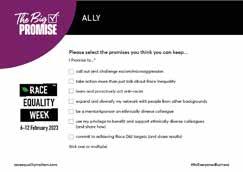
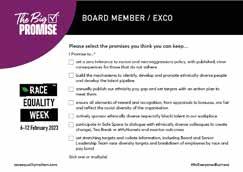
We've made ours. Will you make yours?
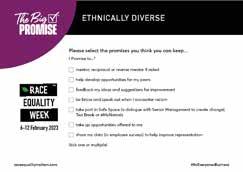
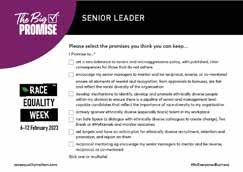




Action – 2 Minutes
To help you make that commitment to change, we have identified bespoke sets of Magnificent 7 promises for:
ExCo/C-suite/Board
Senior leaders
Allies
Ethnically diverse colleagues
The sets of 7 promises have been developed specifically so that each will make a real impact on race inequality in the workplace.
Please look at the promises for your stakeholder group and reflect on which promise or promises you can make.
If you made your Big Promise in 2023, take some time to review and reflect on your progress and decide whether you may want to choose another promise this year.
Choose your Big Promise/Promises.
Promote your Big Promise.
Keep your Big Promise.
Encourage your organisation to implement the Big Promise so everyone gets involved.
Here is one action you can take as a senior leader:
Lead by example. Encourage your team to make a Big Promise and share with them that you are making a Promise too.

Frequently Asked Questions
The 5-Day Challenge
Q: Do we have to do all 5 days of the Challenge?
A: The 5-Day Challenge has been developed to help organisations and individuals understand, learn, and get to know about key race-related issues that affect colleagues and the community. Ideally, we recommend doing all 5 days. However, if for various reasons it is not possible, doing fewer days is still better than not participating at all.
Q: We will not be ready for REW. Can we do the Challenge later in the year?
A: Yes. The resource is relevant 365 days a year. It will not go out of date.
Q: If my organisation does not take part can I do it individually?
A: Yes, however it will have a greater impact if your organisation encourages as many employees as possible to participate.
Q: Can the 5-Day Challenge be used outside my organisation?
A: Yes, it can be used in schools, clubs and community groups. Many do.
It cannot be used for commercial gain. If you would like to discuss using it commercially, please contact info@raceequalitymatters.com and we will see how we can support you.
Q: Do you provide training for any of the subject matter?
A: Please get in touch if you have a budget at our email address, info@raceequalitymatters.com.
Q: Are there any other resources to help me run the 5-Day challenge?
A: There are downloadable guides for each day, and we have included links to additional resources in the guide.
Q: Is there a social media template post we can use?
A: Yes, you will find this and suggested text here: https://www.raceequalitymatters.com/ solutions/5-Day Challenge
Q: Can we donate to support your work?
A: Yes, we rely on funding and donations, please contact info@raceequalitymatters.com
Q: Can we use your logo?
A: The logo is included in the Race Equality Week Participants’ Pack which you will find here: https://www.raceequalitymatters.com/race-equality-week-participants-packfororganisations/ We would appreciate any donations, if possible, should you choose to use it.
The Big Promise
Q: Can we only make a Big Promise on Day 5 of the 5-Day Challenge (Friday)?
A: This is when we feel the majority will do it, but you can do it any day of the week or year.
Q: Would it be possible to select more than one stakeholder category?
• A board member or executive
• Senior leader
• An ally
• An ethnically diverse employee.
A: We appreciate many people may straddle two or three of the categories however, we propose that you select the most senior level you can. Promises made at senior level will enable you to have a greater impact on your organisation - hence select Board and Exco over Ally.
Q: I think colleagues may need some support and guidance to deliver some of the promises.
A: One option is to look at other promises, which may initially be more achievable.
Alternatively, you could open up a dialogue to find out what type of support or training your colleagues might need and come up with collaborative and innovative ways that you could help support them. Furthermore, this could be an important opportunity for change: you could raise this with a line manager or HR department to see if promises could be facilitated and delivered through policy changes or an allocated resource.
We appreciate different organisations and the individuals within them may have access to more resources than others. However, this is an opportunity for you to define the culture of your workforce and where you stand on racial inequality.
If you have a will and a desire for change this may be a time to seek investment to really make a difference.
If you need further guidance and have a budget, you can always contact us, and we will happily discuss ideas with you. Please email us at info@raceequalitymatters.com
Q: Why do I need to type in basic contact details on the Big Promise tool?
A: This information will help Race Equality Matters:
1. Let you know when appropriate support is available.
2. Support individuals to deliver on their Promise.
3. Understand the most common Promises by sector and job title.
Note: Your data will only be used for the purpose of helping Race Equality Matters accelerate tackling race inequality and you can always unsubscribe at any time.
Q: Will you publish my Promise?
A: No, we will not share your Promise but we encourage you to.
Q: Will I be able to find out what Promises my colleagues are making?
A: No, we will not share data or individual Promises, only overarching data, e.g. how many people made Promises, which sectors got involved, the most common Promises selected etc.
If you are keen to know what your colleagues have Promised, you could open a dialogue and discuss whether this is something they would like to share and then you can consider an internal mechanic to capture people’s Promises. However, many colleagues may post their Promises on internal comms channels or social media.
Q: Do colleagues need to share their Promise publicly?
A: The Big Promise was created to help individuals identify and take meaningful action, and to encourage accountability and transparency by visibly sharing their Big Promise. We appreciate some individuals may not want to do this.
Some organisations may encourage their employees to share their Promises via internal comms channels and/or some may want to show they are becoming an antiracist organisation encouraging staff that are comfortable to share their Big Promises externally e.g. via social media. This can create a significant visual impact similar to the one we saw as part of the #MyNameIs campaign.
Q: How else have other organisations used The Big Promise?
A: Organisations have used it in several ways including:
• Printing their Big Promise images and displaying them in canteens and reception areas.
• Sharing their Big Promise with a community.
• Creating a montage of Big Promises and promoting this through social media.
• Creating a video of people sharing their Big Promise.
• Displaying Big Promises on their websites.
Q: Do I make 1 or all 7 Big Promises that are in my category?
A: Our ideal is for every employee to make the one Promise that they will deliver on. With millions of employees in the UK alone we can imagine the impact this will have when the Promises are delivered. However, if someone wants to make more than one Promise then that is fantastic and possible. Many people do.
Q: When I have delivered on my Big Promise is that it?
A: The idea is for everyone to start to make a difference, with their first Promise.
We would therefore encourage employees whether it has been three months, six months or a year later to make their second Promise. Tackling race inequality is not a one-off thing. The idea of having seven Big Promises per stakeholder group is that over time individuals will deliver on them and accelerate the drive to race equity and equality.
Q: Do you want to hear about our organisation’s Big Promises?
A: Absolutely, we are very keen to hear how the Big Promise has been adopted in your organisation and the impact it is starting to make. We can also help publicise it. In addition, we can advise you if we feel your organisation should consider applying for Race Equality Matters Trailblazer status. This is an acknowledgement and recognition of the progress your organisation is making towards eradicating race inequality and promoting the fact that#ItsEveryone’sBusiness to #ListenActChange.

Acknowledgements
Curated by The Collaboratory and the Race Equality Matters Team
Designer - Nick Farrow
Proof-reader - Peri Lyon
Big Promise Tool – FL1
Thank you to the Race Equality Matters change-makers:
Asif Aziz | Cadent
Komal Jethva | Allegis Global Solutions
Nicky Lintott & Hilton Vera | Elysium Healthcare
Valentina Othieno | Bruntwood SciTech
Carlyn McAndrew, Elspeth Wedgwood & Louise Hughes | Shepherd and Wedderburn LLP
Karen Parry | Inclusion North
Lisa Boyack & Tracey Greener | Changing Lives
Elena Piccinelli | Iscte - University Institute of Lisbon
Aneeka Neehaul | Rethink Mental Illness
Olu Obafaiye | Hammersmith & Fulhuam Council
Fiona McLeod | BBC
Tricia Wombell | Recruitment & Employment Confederation
Jessica Harvey | Walker Morris LLP
Fiona Keady & Yvonne Gordon | Leidos
Janet Parmenter-Delaney | Pathway Care Fostering
Carol Gardner | NHBC
Craig Malia | North Yorkshire Police
Alyson Malach | Equality and Diversity UK
Charlotte Ajomale-Evans | Changing Corporate Culture
Charlotte Claydon | Bristol Old Vic Theatre School
Amanda Johnlewis | NHS
Elyn Hannah and members of Diverse staff network | Vale of Glamorgan Council
Ash Holich | Hull City Council
Sonia Baryschpolec
Lisa Ampah
Katharine Friedmann | Leicestershire County Council
Monica Stancu | Lloyd's
Jas Kaur | Birmingham and Solihull Mental Health NHS Foundation Trust
If you found today's challenge helpful you can support us to create more solutions
Race Equality Matters provide many solutions resources and events for free, so:
1. Everyone can access them, regardless of budget.
2. The real barriers to race equality in the workplace are addressed.
3. The change we all want to see and feel, is accelerated.
91% say what we are doing will make an impact.

(Donate via this QR Code)
If you or your organisation can help, your donation will mean the world and help end racial inequality. Thank you











